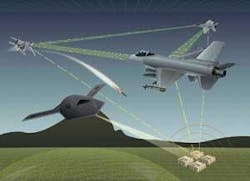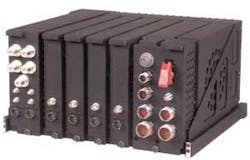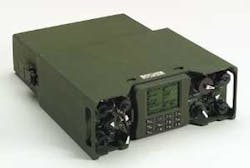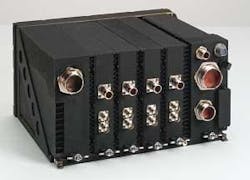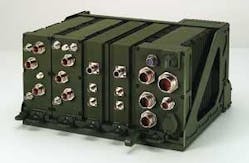U.S. military leaders are moving forward with new space-based, land-based, and forward-deployed wireless tactical networks to bring Internet-like information-retrieval systems to military leaders, logistics experts, and warfighters who all seek the same goal: shared battlefield knowledge.
BY JOHN KELLER
The entire notion of force transformation-the network-centric vision of tomorrow’s U.S. military-rests on one core capability: sharing knowledge in real time. Shared knowledge is far different, however, from simply fire-hosing combatants with information. Shared knowledge has to do with providing just the right information to just the right people at just the right time. No more, no less. Achieving this requires a complex and delicate balance of computers and interconnected data networks that can link all U.S. and allied forces, from the president of the United States down to riflemen in foxholes.
That ability of everyone involved to see just the right piece of the whole picture with few, if any, time delays will enable the so-called transformational capabilities of tomorrow’s military force, such as massing firepower without massing forces, using relatively small and light forces that are more deadly than ever before, and predicting the enemy’s moves before the enemy makes them.
Transformational communications is a whole new way of looking at military operations, capability, and procurement. “Transformation is a change in the market, based on an opportunity to create network systems where traditionally we had proprietary point-to-point stovepipe communications. Now, with net-centric warfare, rich information is a principle of war,” explains Terry Morgan, director of defense network strategies at the Cisco Systems Inc. global defense, space, and security group in Herndon, Va. Cisco is adapting its communications switches and networking technologies for military applications on land, at sea, in the air, and in space.
“Transformation is really about thinking differently, and about connecting existing things in different ways to achieve new capabilities,” says U.S. Air Force Col. (and brigadier general-select) Gary S. Connor, head of the Command and Control, Intelligence, Surveillance, and Reconnaissance Systems (C2ISR) Wing of the Air Force Electronic Systems Center at Hanscom Air Force Base, Mass.
“Examples of this are taking video from the Predator unmanned aerial vehicles and integrating that video on an AC-130 gunship to give the AC-130 crew a way of precision targeting,” Connor says. “Another example is taking Predator video and providing it to the special operations folks. You could have special- ops people riding horseback through the desert, and using Predator video on their laptop computers or PDAs to see what is over the other side of the next hill. This is what we mean by ‘power to the edge.’ ”
Sometimes a precise definition of transformational communications is hazy. “What is transformational communications? The real definition is still being defined,” says Rick Sanford, director of space initiatives with Cisco global defense. “In transformation we get the acquisition and requirements-generating offices, the prime contractors, and systems integrators to think beyond the actual requirement of the mission at hand, to look at a future of globally interconnected functionality. We fundamentally change the way people think about deploying these systems, and look at the big open Internet.”
It is the Internet, after all, that is providing a model for the brave new world of transformational communications-a broad and deep source of voice, data, and imagery available graphically and based on the widely deployed and well-understood Internet Protocol (IP). This differs fundamentally from most existing military communications systems that have some rudimental networking capability, but largely are point-to-point links over land-mobile radio, wires or optical fiber, or satellite data links.
Operationally, the foundation of transformational communications rests on four primary supports: the Transformational Satellite Communications system, or TSAT; the Global Information Grid Bandwidth Expansion, or GIG-BE; the Warfighter Information Network-Tactical system, or WIN-T; and the Joint Tactical Radio System, or JTRS.
TSAT
TSAT, which is to be fully operational in 2006, essentially will be a high-speed Internet data network in the sky, providing crucial wideband connectivity between terrestrial data networks such as the GIG-BE, and battlefield networks such as the WIN-T, JTRS, or relatively old military data networks.
TSAT will be an eight-satellite constellation with worldwide coverage. Five TSAT satellites will be in geosynchronous orbit to handle most of the workload, while three lighter, less-capable satellites called the Advanced Polar System will be in polar orbit to help cover potential communications gaps.
Free-space laser crosslinks running at 10 gigabits per second will connect the satellites to one another. Other free-space lasers will connect the satellite network to high-altitude manned and unmanned aircraft at two gigabits per second.
Extremely high-frequency (EHF) and Ka-band radio-frequency (RF) links running as fast as 311 megabits per second will connect satellites to ground stations, while RF links from 256 kilobits per second to 45 megabits per second will connect the TSAT network to forward-based ground terminals. The speed depends on the capabilities of the terminals, says Dr. Troy E. Meink, the TSAT program manager in the U.S. Department of Defense Military Satellite Communications Joint Program Office at Los Angeles Air Force Base, Calif. Lasers cannot reliably link with sites on the Earth’s surface because of clouds, precipitation, dust, and other obscurants.
TSAT’s optical crosslinks will be solid-state lasers with 1- to 10-watt amplifiers, with digitally reprogrammable routers. The TSAT routers will make broad use of the latest digital signal processors and field-programmable gate arrays, and will use the latest high-speed Internet Protocol: Internet Protocol Version 6, or IPv6.
Military leaders will choose a contractor to build and deploy the ground-based TSAT mission operations system before the end of this year, Meink says. This TSAT ground segment will handle mission planning, network operations, policy implementation, and key cryptographical management. Three contractor teams are vying for this project, led by Raytheon Co. in Aurora, Colo.; Northrop Grumman Corp. Mission Systems in Reston, Va.; and Lockheed Martin Information Support Services in Gaithersburg, Md.
A contract for the TSAT space segment will be let in late 2006. Two industry teams led by Lockheed Martin Space Systems Co. in Sunnyvale, Calif., and Boeing Satellite Systems in El Segundo, Calif., are competing for the job, and are concentrating on developing TSAT digital processors, laser communications, and advanced antennas.
TSAT is expected to improve the communications capabilities of deployed military forces by an order of magnitude. Today’s Military Strategic, Tactical & Relay II (MILSTAR II) satellite communications system, for example, takes two minutes to transmit a 24-megabyte 8-by-10-inch image, while the TSAT system should be able to do that in less than a second. First launch of the TSAT spacecraft will be in 2013, initial operating capability is set for 2015, and full TSAT operation is set for 2018.
GIG-BE
The Global Information Grid Bandwidth Expansion is to provide data bandwidth sufficient to improve voice, data, and video communications for strategic intelligence, surveillance and reconnaissance, and command and control information sharing-all on a common ubiquitous military architecture, says Tony Montemarano, program director for the GIG-BE program at the Defense Information Systems Agency (DISA) in Arlington, Va.
The program seeks to install an advanced optical-fiber mesh network to connect 90 key intelligence, command, and operational locations in the continental United States and in the Pacific and European regions over physically diverse routes. The exact locations of these installations are secret, Montemarano says.
“The expectation is there will be an enormous requirement for communications, and the concept of reaching back to access information for troops in the field will mean that fewer troops have to go out,” Montemarano says. “The GIG-BE and transformational communications is to have this global grid infrastructure where you can get any information you require, provided you have access to that infrastructure.”
The GIG-BE program seeks to build a military-only global information backbone, which departs significantly from today’s approach where military authorities lease bandwidth from commercial providers. “We just lease more bandwidth when we need it from commercial carriers today,” he says. “In GIG-BE we are prepositioning bandwidth at key installations throughout the world, so that as load on infrastructure expands, the bandwidth can be scaled readily.”
“We have 40 percent of the equipment deployed now, but only 16 sites lit up. The sites vary in size. Some have 30 racks of equipment, and others have as low as two racks of equipment. We concentrate on the big sites first-the core of the GIG-BE itself.” The entire $850 million project is to be finished by the end of this year.
Managing the GIG-BE equipment acquisition for GIG-BE is Science Applications International Corp. in San Diego. Ciena Corp. in Linthicum, Md., handles long-haul transport; Sycamore Networks Inc. in Chelmsford, Mass., is in charge of optical cross connects; Juniper Networks Inc. in Sunnyvale, Calif., is handling IP routing, and Cisco Systems Inc. in San Jose, Calif., is handling intelligent multiplexers called multiservice provisioning platforms. The providers of optical fiber are secret, Montemarano says.
“We are using optical mesh, and electro-optical transport; we are doing nothing new,” Montemarano explains. “The only thing that is significant is in the larger infrastructures we are introducing high-assurance IP encryption into the wide-area network, where we encrypt traffic at the IP layer.” This is different from many other protected systems, where security and encryption happens at the physical layer, he says.
This approach allows for ubiquitous use of a common infrastructure, as the protection is being moved out to the end, according to Montemarano. “We believe it is as secure as that of the physical-layer protection,” he says
WIN-T
The Warfighter Information Network-Tactical is a battlefield communications backbone that supports voice, video, and data applications such as the JTRS, and the Future Combat Systems (FCS).
The system will mandate standards and protocols for all so-called “Objective Force” applications and network hosts, and will use the most advanced communications, ground vehicles, aircraft, satellites, and computers, and is one of the ways that national command authorities can communicate with front-line forces via the GIG-BE and TSAT.
Two industry teams are vying to be the WIN-T integrator, which will be decided in 2006: General Dynamics C4 Systems in Taunton, Mass., and Lockheed Martin Corp. in Gaithersburg, Md. WIN-T is to be fielded in 2008.
JTRS
The Joint Tactical Radio System will be a family of interoperable software-programmable tactical radios that transmit and receive voice, data, and video communications among the different U.S. military services and between U.S. forces their allies.
In essence, JTRS will be to radio communications what the personal computer is for information processing, experts say. Standard computer and radio hardware will host standard radio functions in an open system, similar to Intel-based PCs and Windows software.
The key to the JTRS is a layer of standard software called the Software Communications Architecture, or SCA-“a set of rules and protocols for software-defined radio applications,” explains Mark Turner, director of JTRS engineering at Harris RF Communications in Rochester, N.Y. Those rules and protocols define an operating environment, or infrastructure, that abstracts the low-level software and hardware, and is what the waveform applications will run on top of, just like Microsoft Word runs on Windows.”
null
Turner says the SCA has four basic pieces: the Posix operating system interface, middleware for distributed processing, a core framework, and a services and devices layer. The Posix layer is a software interface that will support any Posix-compliant real-time operating system; the SCA requires the use of Posix, which isolates the operating system from application software to enable applications to port easily between different hardware architectures.
The middleware layer uses the Common Object Request Broker Architecture (CORBA) to handle distributed processing. “This insulates the rest of the software on top of it from the details of where that software is employed,” Turner says. The core framework layer “allows for system configuration and control that figures out how to deploy the components of the waveform application and where to run them, how to connect them together,” he says. The services and devices layer, meanwhile, supports applications in the same way that APIs support Windows software applications.
“Ultimately the waveforms developed will be tested and verified by JTRS test and evaluation laboratories, and when they are approved, they will be validated for SCA compliance and will get put into a government repository,” Turner explains. “Then they will be provided to platform suppliers under contract to port to platforms.”
The SCA is akin to a software-defined radio’s operating system, but more accurately “is the radio-manager system. It is the software that will take the executable or libraries of the application and will deploy it at the proper location in the computer, such as targeting software to a Pentium, an FPGA, or a DSP,” explains Claude Belisle, research manager at the Communication Research Center in Ottawa, the group leading efforts to move the SCA in to commercial and homeland-security applications.
“It is the SCA that makes the bridge between the developer and the hardware platform. As long as the software developer programs according to this architecture, the SCA will take care of the rest. It is there to load and unload and start the application. Once it is all loaded, the SCA pulls out and does monitoring of the radio itself. Then the software can run as fast as any other software.”
The SCA should create the flexibility necessary not only to field new radio applications quickly, but also to develop and field new radio hardware quickly, says Bruce King, vice president and general manager of communications systems at Rockwell Collins Government Systems in Cedar Rapids, Iowa.
“The SCA allows a tremendous amount of flexibility, interoperability, portability, and reusability,” King says. “We don’t have the ability to take years and years to field new capabilities for our users, so we need a framework in place that allows industry to field capabilities quicker and more efficiently.”
Rockwell Collins is developing the HF capability and HF automatic link establishment, air-traffic-control VHF voice and data, and air-traffic-control HF capability for JTRS Cluster 1. Other waveforms to go into JTRS include UHF satellite communications modes such as Demand Assigned Multiple Access satcom, Link 11, Link 4A. SINCGARS, EPLRS, Have Quick, and Link 16.
“Ultimately there will be new waveforms added, such as the Wideband Networking Waveform. WNW, which will create an ad-hoc mobile networking environment like a wireless Internet protocol,” King says. “Future waveforms might be for tactical targeting networking technology, and high-speed, low-latency tactical data links. You will see the processor (CPU) or the radio will become the platform to host the applications to grow as the warfighters needs grow.”
Transformational communications aims at the warfighter-the ‘point of the spear’
By J.R. Wilson
The world of military communications is on the verge of massive and revolutionary change, from new generations of satellites providing greatly enhanced bandwidth, speed, and capability to the final realization of a two-decade drive toward a networked battlespace. In the end, however, the single most important element-the place where nothing else matters unless it works there-is the individual soldier, sailor, airman or Marine on the front line of combat, or what typically is referred to as the “pointy end of the spear.” For them, not all that much has happened-yet.
“Most communications at the squad level haven’t changed much in the last several years. The most significant improvements in that area have come in the form of upgraded and newer multiband multimode radios, mostly in terms of voice, very limited in terms of data,” explains Gary Martin, acting technical director at the U.S. Army Communications-Electronics Research, Development, and Engineering Center (CERDEC) at Fort Monmouth, N.J.
Examples of improvements are the AN/PRC-148 Multiband Inter/Intra Team radio (MBITR) multiband integrated tactical radio from Thales Communications in Clarksburg, Md., which is the latest communications upgrade at the infantry squad level. In UHF satellite communications (satcom), which is for beyond line of sight, the AN/PRC-117 Falcon II radio from the Harris RF Communications Division in Rochester, N.Y., is the latest to be fielded, he says.
Augmenting this capability have been commercial systems such as Iridium, which the U.S. Department of Defense (DOD) essentially took over as the primary client several years ago. Commercial systems have helped, but only to a point. “The big gap has been data communications,” Martin says.
Wireless data communications on the battlefield have been available only at very low transfer rates over high frequency (HF) or satcom, he says. Reversing that is one of the major goals of short- and long-term systems now in development.
“One of the challenges we face today is that not every soldier has access to everything on the battlefield,” Martin points out. One project that seeks to address that challenge head-on is the digital Joint Tactical Radio System, better known as JTRS-a “family” of software-programmable tactical radios that transmit and receive voice, data, and video communications, and provide interoperable communications among the different U.S. military services and between U.S. forces their allies.
U.S. military forces are developing and buying JTRS as a “family” of radios for different applications. Each family of JTRS is called a “cluster.” The Army-led Cluster 1 JTRS is for Army and Marine Corps ground vehicles and Army helicopters, as well as for Air Force ground-based tactical air controllers. Cluster 2 is for special operations forces and will upgrade the existing Multiband Inter/Intra Team handheld radio to JTRS standards. Cluster 3 is for ships, submarines, and fixed-site applications, cluster 4 is for aircraft radios, and Cluster 5 is for handheld, manpack, and small radio sets for embedding in tight spaces such as the Army’s Future Combat Systems platforms.
“There are a number of systems we are working on under JTRS that will greatly enhance squad level communications,” Martin says. “That is the most significant enhancement we will have done in the last several years in terms of soldier communications, not only voice but multimedia, which would support squad level situational awareness and Blue Force (friendly) tracking.”
The emphasis on providing advanced communications capability to the frontline soldier is part of a renewed awareness on DOD’s part that the individual human warrior is more than just a weapon; he or she also is one of the best “sensors” the military has when the inevitable “fog of war” overwhelms battle plans and mechanical sensors cannot provide the level of detail required to understand fully what is happening at the front.
“The soldier on the ground has the best local knowledge out to about 300 meters,” says Lt. Col. Steve Iwicki, Director of Army Focus Area-Actionable Intelligence in the Army’s headquarters intelligence section (G2). “Theater and national organizations in theater or even CIA-level have the best strategic level knowledge across the board, but little resolution on what is happening on the ground level-great for the big picture, but can’t zoom in much; soldiers are the opposite. We need to merge the two so information flows from top to bottom and bottom to top.
The fight for knowledge
“The key theme in Army transformation is the fight for knowledge, not just collecting data but making sense of what we already have-know what we already know,” Iwicki continues. Martin says that is part of the “system of systems” approach the military is taking with communications across the board for all the services. That goal also covers the need to communicate with coalition partners, many of whom are equipped with far older, less capable radios.
“In situational awareness, it is largely push, multicast out to all users,” Martin explains. “When it comes down to sensor data, whether imagery or voice, most of that I believe will wind up being pulled. Most of DOD is migrating to publish or subscribe, where the individual will subscribe to a service-updated maps, intel imagery, etc.-and they can then pull that data at their leisure. All the services are headed for a publish/demand scenario, where users will basically have technology much like today’s Google and Yahoo web searches, but based on messages telling you something has been published on a specific server.”
Achieving that goal will require evolutions in tactics, techniques, and procedures as well as equipment from the national command authority level down to the individual warfighter. A significant enabling technology will the JTRS software defined radios (SDRs) for interservice as well as coalition interoperability. Key to making that work on the battlefield will be creating a gateway functionality that will make the entire operation transparent to the users.
That will begin to reach the squad level within five years, then move down to the individual warfighter fairly rapidly, predicts Bruce King, vice president and general manager of Communication Systems at Rockwell Collins Government Systems in Cedar Rapids, Iowa.
“Some things are being done today with technology that are transitional, not so much on the network front, but some transitions and migration points on how to extend our product family into communications ranges that also include civil, because of the need to communicate with both,” King says. “I would draw an analogy to the PC market; the focus was on the hardware, but now hardware is almost secondary. You’re still going to have fixed communications over fixed waveform-there’s no magic switch that will enable communications across all spectrum at the same time.
“The equipment we will field in the future will allow a more robust communications network,” King says. “If a forward medical unit does not have line-of-sight communications due to terrain or topography, the communications system that will be fielded will provide other avenues of connectivity. So flexibility will be inherent in the system, but only to the level they are equipped with when they leave base. The number of users on the net will be adjustable on the fly, but how they then use it will depend on how they are equipped. In the end, however, allowing a soldier in a firefight to access situational awareness data relevant to his needs is exactly where we’re going.”
Much of what will be possible in meeting that goal will depend in large measure on the future of microchip technology. “Until the computer and sensor technologies become small enough to fit into the palm of someone’s hand, those devices likely will be communicating with an infrastructure deployed behind to support that person,” notes Eran Strod, director of product marketing at Mercury Computer Systems Defense Electronics Group in Chelmsford, Mass. “Mercury is providing support to the arteries and capillaries of that support structure. Our customers build the end-user applications and we provide the building blocks and enabling solutions. So we focus on the computer capability on behalf of all these efforts.”
In an age of shifting alliances and no monolithic adversary providing a common threat, future technology must enable communications across a wide and varied battlefield capability. “In this new world of ours, you can think of engagements with different coalition partners at different times and you want to be absolutely secure, but at the same time flexible, to enable communications with other individuals and infrastructure, yet also have the flexibility to disable those links when you are in a different situation,” Strod says.
“Another problem our customers face in these mobile platforms involves the capability to collect data with a UAV (unmanned aerial vehicle), which far exceeds the bandwidth to download it, so it is important to have the proper computer infrastructure to organize, filter and order the data to go through the narrow straw that is the handheld device.”
To anyone who fought in Vietnam, where the standard for field communications was still one soldier with a manpack radio following the platoon or squad leader around, today’s fielding of handheld radios to individual soldiers might seem a quantum leap. While it is a significant improvement, there remain serious gaps in capability to be addressed.
“As we go into the vision for FCS, where every soldier is a sensor with a robust deployment of unattended and unmanned sensors, the need to actually get the soldiers fully equipped becomes mandatory,” Martin says. “Mobile ad-hoc radios built to support a much broader deployment don’t work well if you only have a few. So the idea of ubiquitous radios deployed to every soldier is where the Army is going-providing a fairly robust capability not only for every soldier to have in the field, but also in urban environments, as well as dense forest or jungle, where you would need to reroute through many nodes.
“SINCGARS and embedded radios recently fielded won’t do that, but taking the soldier into the 21st century as part of FCS depends on it, Martin continues. “The fundamental technologies are here and we will begin to see those in the field, integrated into units and individuals, by 2015. That may seem like forever to the soldiers in the field today, but it is actually very soon.”

